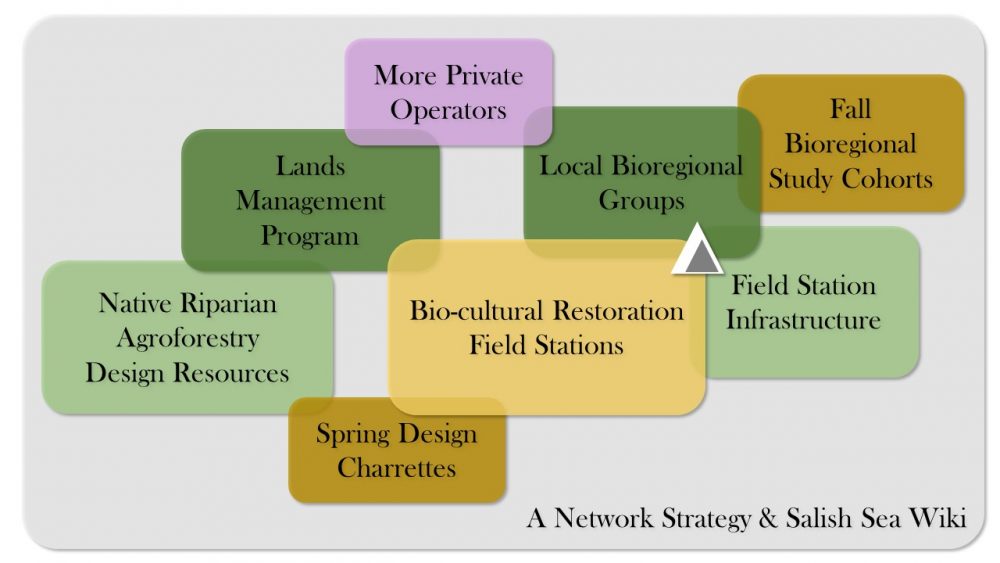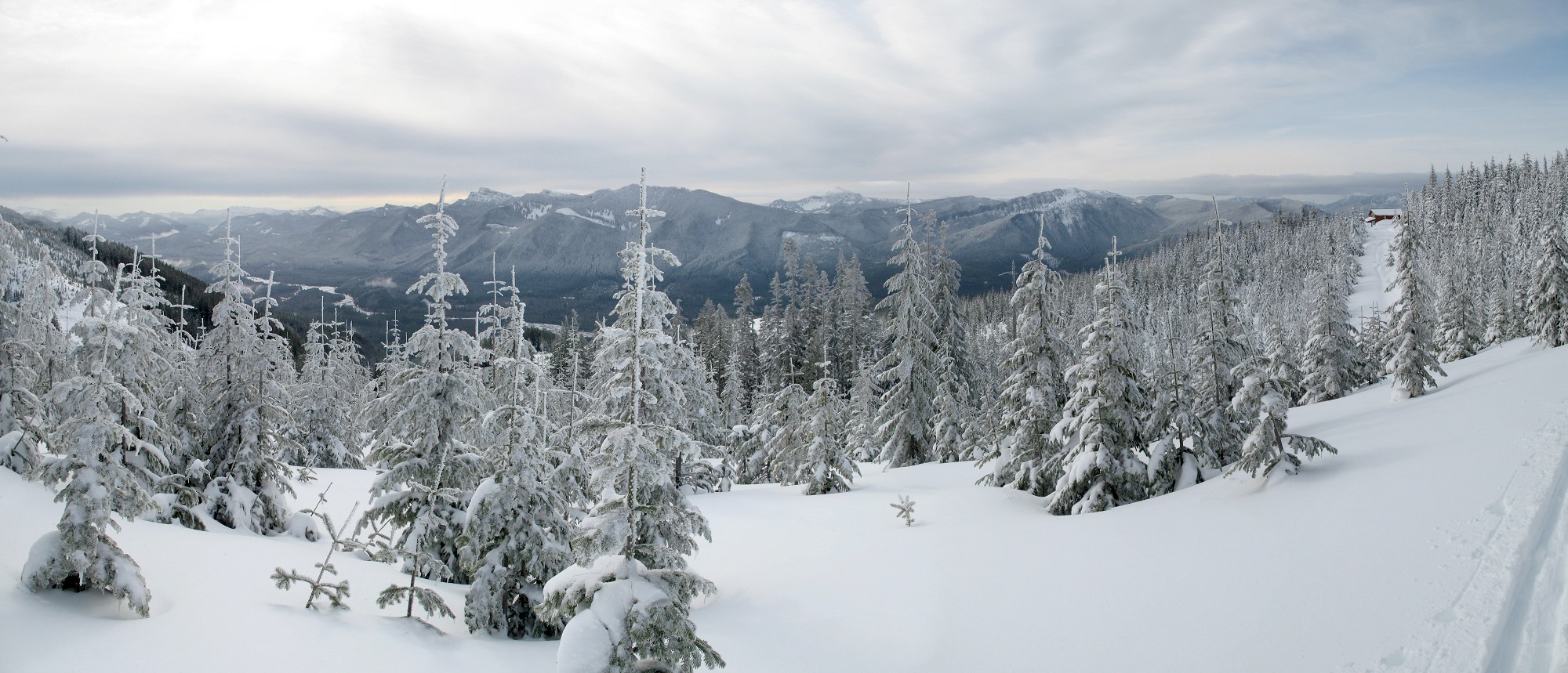This is a different kind of update. There is no play-by-play description of activites. Instead here is a snapshot of the emerging system that I have been working on. Heretofore its mostly been in pieces, only part of a living whole in my imagination. Lets see if I can lay it out in brief terms:
I’d like us to invent a bioregional network, capable of doing work together, while minimizing dependencies on hierarchical institutions or industrial currency.
I suspect that to restore our bioregion will require a self-replicating swarm of skilled people to start tending “public trust landscapes”. Public Trust Landscapes are the web of forests, soils, wetlands and streams which creates ecological functions that are shared by all and are held in trust for our children: water quantity, water quality, flood storage, biodiversity, carbon storage, agricultural production capacity, and fish and wildlife populations. Private landowners when left isolated in global markets, have proven to degrade neglect these public trust functions.
We need to rebuild a cultural foundation for stewardship. By working, eating, and telling stories around a fire in cultivated semi-wild forest gardens we grow new relationships among people and with the earth, and are happier. By cultivating our needs locally we reduce our dependency on global colonial-industrial systems and thereby reduce harm, and create new opportunities. Bioregional regeneration is tangible work. Wetlands, streams, rivers and floodplains have been damaged and neglected. If bioregionalism doesn’t naturally tend land through cultural processes, without being instructed to do so by institutions or only when seeking personal income, it reeks of fakery. Landscape regeneration and stewardship must be a lifestyle choice.

Here is my hypothetical model, corresponding with the diagram above, with key elements from the diagram capitalized in text: BIOCULTURAL RESTORATION FIELD STATIONS are the place where LOCAL BIOREGIONAL GROUPS can congregate to tend patches of vegetation. Patches of vegetation make up woods and wetlands, and woods and wetlands make up landscapes. To arrive at any site and work comfortably using local energy sources, we develop FIELD STATION INFRASTRUCTURE–a tool kit of appropriate technology that conveniently also provides education about how to live sustainably, as well as disaster resilience. While stepping away, and living at a field station we are momentarily carbon positive, restoring ecosystems, and among colleagues, close to nature.
SPRING DESIGN CHARRETTES are annual gatherings hosted by a field station where we redesign specific ecosystem patches. These designs inform our work in the landscapes around field stations. These collaborative and iterative design efforts both depends on and generate NATIVE AGROFORESTRY DESIGN RESOURCES–the lists and practices and patterns that inform how we semi-wild vegetation. We can collectively store and retrieve these resources on the SALISH SEA WIKI.
By doing good work, field stations create friendships and trust. Friends expand land access through an increasingly sophisticated LANDS MANAGEMENT PROGRAM. Our institutional stewardship of public trust landscapes is currently a mess of private parcels, regulations and government incoherence. This requires organization and improvement. Only a locally developed program can re-integrate private, local, state, and federal regulations and incentives into a coherent system. Land managers can then enroll in such a program and make friends and gain benefits and freedom, within a system of responsible stewardship.
Design resources and land access organized around management empowers MORE PRIVATE OPERATORS cultivating native agroforestry systems in public trust landscapes–we start to grow food and materials while restoring biodiversity and ecological functions in our damaged and neglected commons. These emerging production systems are incubated by the network of bioregional groups, that support incubation with labor and infrastructure.
Local bioregional groups in turn independently support the development of more groups. We cultivate strength through FALL BIOREGIONAL STUDY COHORTS–offering bioregional integrated social-ecological design parallel to and complementing existing educational institutions. Through these study groups, we cultivate a NETWORK STRATEGY to increase information exchange, and how to cultivate shared knowledge on the SALISH SEA WIKI (including design resources, social and physical infrastructure prototypes, management templates, and networking strategies). We refine a shared map of a social and ecological commons; an expanding public trust landscape. We build our ability to engage in productive local governance, modify local codes to support regenerative lifestyles, and develop more field stations to gather more groups.
I am not suggesting this model as an institutional possession or an authorized effort. I am suggesting a pattern for increasing shared assets and creating new authorities, adjacent to and complementary to existing institutions and authorities. All these components would be open-sourced and designed for collective stewardship by independent but coherent groups. I am investing my imagination, labor and time in this model, because I believe it has potential. I am happy to adapt as I get feedback, I’d like to work with you.
I am encouraging our formation of prototype groups around our first field station on the Lower Skykomish on a hundred acres of riparian forest. We have three gatherings scheduled through winter. Our first hosts are the Tulalip Tribes and the Snohomish Conservation District. We have a functioning risk management model and land access agreement. Many many more sites with neglected vegetation and soils in beautiful and ecologically important locations are waiting. You, my dear reader, are part of a potential bioregional group. With friends of friends you number in the thousands. Our infrastructure is rudimentary but slowly growing: fast group shelters, portable wood fired cooking and heating, mobile composting toilets. We have much to learn and do. We have some incoming resources to help willing groups develop infrastructure. I am personally working on a simple portable high-draft wood burning heater/stove. We anticipate our first design charrette this spring of 2023. I began networking around regulatory and incentive program coordination seven years ago, and we are positioned to launch a more formal venture this spring. A flood of state and federal grant makers are hungry to fund anyone with a coherent solution to our ecological crisis. The Salish Sea Wiki is getting an upgrade and migrating to ownership by the Society for Ecological Restoration. There is work for many hands. I propose we host our first bioregional study cohort this fall.
I would love to hear your thoughts, questions or concerns. Even more, I would love to talk around the campfire at a field station.


